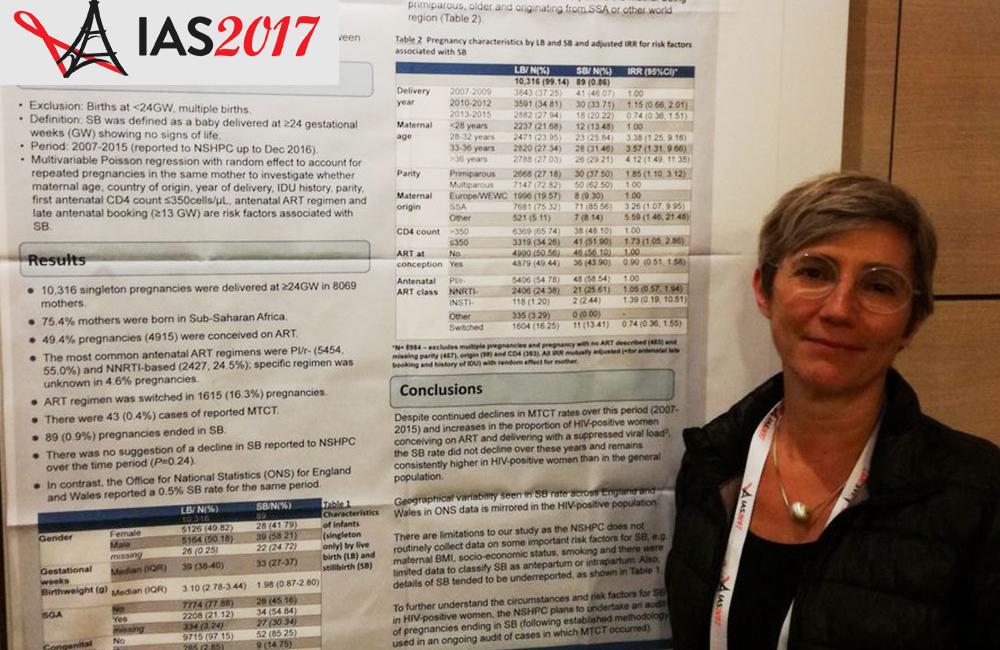
The stillbirth rate among women living with HIV in the UK and Ireland from 2007 to 2015 was more than twice that of the general population, Graziella Favarato, presenting on behalf of the National Study of HIV in Pregnancy and Childhood (NSHPC), told participants at the 9th International AIDS Society Conference on HIV Science (IAS 2017) in Paris last week.
Women living with HIV are significantly more likely to experience pre-term delivery, to deliver babies with low birth weight and to have a stillborn baby. Much of the data on the risk of adverse birth outcomes comes from sub-Saharan Africa and less is known about adverse birth outcomes in higher-income settings.
Dr Favarato and colleagues looked at the current rate of stillbirth and associated risk factors among women living with HIV who delivered in the UK and Ireland from 2007 to 2015.
Established in 1986 to monitor paediatric patients with AIDS, the UK and Ireland’s NSHPC has conducted comprehensive population-based surveillance of HIV in pregnant women since 1990. Maternal, perinatal and paediatric data is collected through two parallel, confidential and voluntary reporting schemes: an obstetric scheme for the notification of pregnancies in women living with HIV and a paediatric scheme through which infants exposed to HIV and children who have HIV are reported.
The analysis included data from single births delivered at 24 gestational weeks or later. Stillbirth was defined as a baby delivered at 24 gestational weeks or later with no signs of life.
Of the 10,405 pregnancies 89 (0.9%) were stillborn; in the general population, stillbirth is estimated to be in the region of 0.4%.
The proportion of stillbirths declined over time, from 1.1% (41/3884) during 2007 to 2009, 0.8% (30/3621) during 2010 to 2012 to 0.6% (18/2900) during 2013 to 2015.
Most women were on antenatal antiretroviral protease inhibitor-based and non-nucleoside reverse transcriptase-based regimens each accounting for 0.9% of stillbirths among all women on these regimens, 48/545 and 21/2427, respectively. While fewer women (120) were on integrase inhibitors they delivered the highest proportion of stillbirths (1.7%).
Mothers delivering a stillbirth were over three times more likely to receive no antenatal antiretroviral therapy compared to those delivering a live birth, 5.8 vs 1.6%.
Stillbirths compared to live births were more likely to be male and small for gestational age, 58 (39/67) vs 50% (5164/10290) and 55 (28/62) vs 21% (2208/7774), respectively. Stillborn infants were also more likely to be delivered pre-term at a median of 33 (IQR: 27-37) gestational weeks compared to 39 (IQR: 38-40) gestational weeks for live-born infants.
Over half of stillbirths were very preterm (less than 34 gestational weeks) compared to under 5% of live births, 46/89 (52%) and 409/10302 (4%), respectively.
A considerably higher proportion of stillbirths had congenital abnormalities compared to live births, 15 (9/61) vs 3% (285/10000).
Most women originated from a sub-Saharan African country, accounting for 0.9% of stillbirths (71/7752) while stillbirth among women from Europe or westernised countries accounted for 0.4% (8/2004) with the highest proportion (1.3%) of stillbirth among women originating from other countries (7/528).
The risk of stillbirth was three times greater among women whose country of origin was in sub-Saharan Africa and six times higher in women from another world region compared to women in Europe and higher-income countries (IRR: 3.26, 95% CI: 1.07-9.95 and IRR: 5.59, 95% CI: 1.46-21.48 respectively).
While most mothers in both groups booked their first antenatal care appointment in the second trimester or later (at 13 gestational weeks or later), more mothers delivering a stillborn infant did so, 93.1 vs 86.8%.
Close to half of mothers delivering a stillborn infant had a first antenatal CD4 cell count of 350 cells/mm3 or less compared to approximately a third of those delivering a live birth.
In multivariate analysis, significant risk factors for having a stillborn child included: having a first antenatal CD4 cell count below 350 cellsmm3, incidence rate ratio (IRR): 1.73, (95% CI: 1.05-2.86) and being the mother’s first pregnancy, IRR: 1.85, (95% CI: 1.10-3.12).
Women of older age (over 36) compared to those under 28 had more than a fourfold greater risk of delivering a stillborn infant, IRR: 4.12, (95% CI: 1.49-11.35).
Favarato G et al. Stillbirth in HIV-infected women in UK/Ireland between 2007 and 2015. 9th International AIDS Society Conference on HIV Science, Paris, abstract MOPDC0104, July 2017.
View the abstract on the conference website.
Download the e-poster from the conference website.
Download the presentation slides from the conference website.
